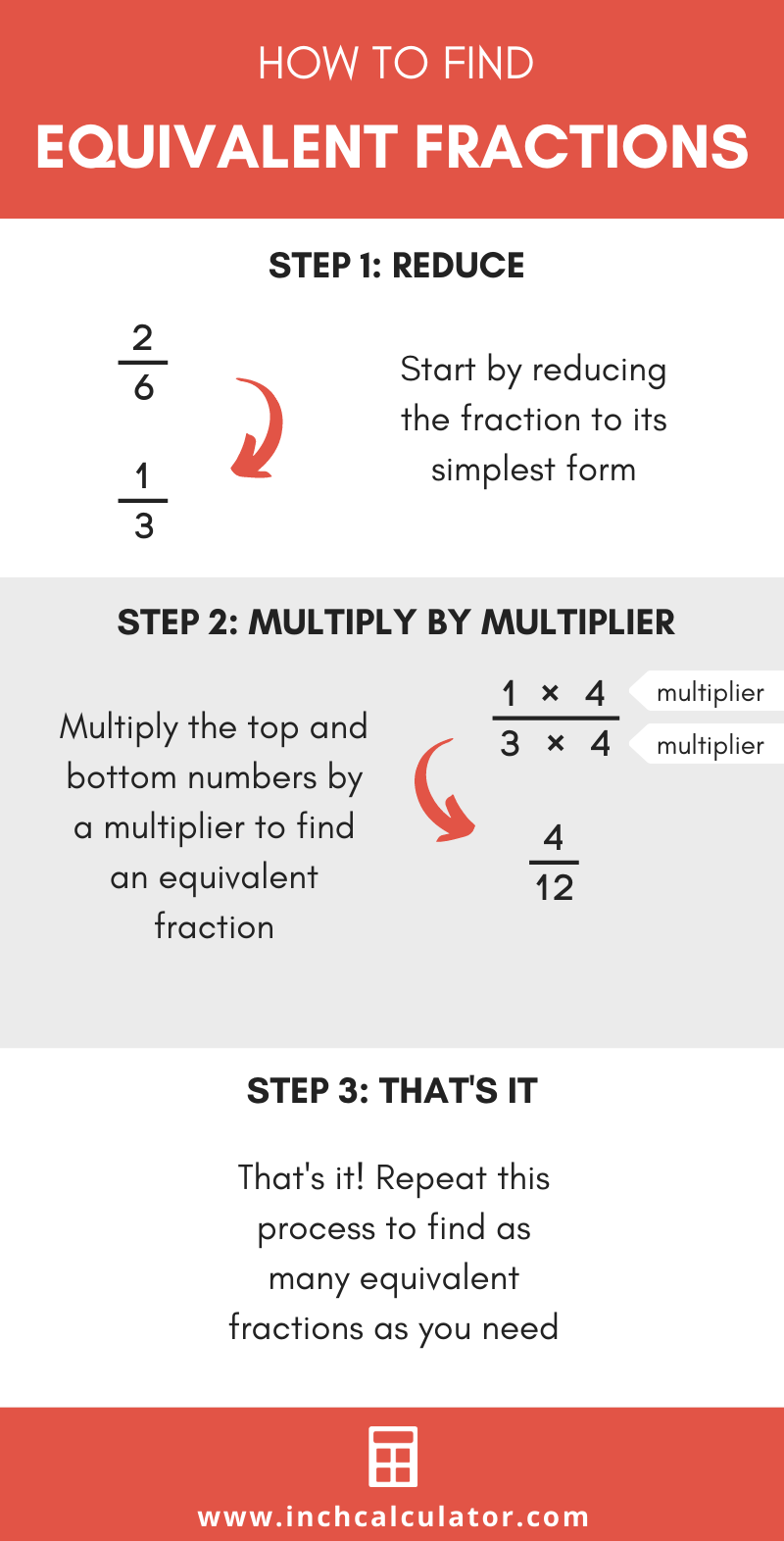Equivalent Fractions Calculator
Calculate equivalent fractions for a proper, improper, or mixed fraction or whole number using the calculator below. The results include the first 100 equivalent fractions.
Equivalent Fractions:
| 4/6 | 6/9 | 8/12 | 10/15 |
| 12/18 | 14/21 | 16/24 | 18/27 |
| 20/30 | 22/33 | 24/36 | 26/39 |
| 28/42 | 30/45 | 32/48 | 34/51 |
| 36/54 | 38/57 | 40/60 | 42/63 |
| 44/66 | 46/69 | 48/72 | 50/75 |
| 52/78 | 54/81 | 56/84 | 58/87 |
| 60/90 | 62/93 | 64/96 | 66/99 |
| 68/102 | 70/105 | 72/108 | 74/111 |
| 76/114 | 78/117 | 80/120 | 82/123 |
| 84/126 | 86/129 | 88/132 | 90/135 |
| 92/138 | 94/141 | 96/144 | 98/147 |
| 100/150 | 102/153 | 104/156 | 106/159 |
| 108/162 | 110/165 | 112/168 | 114/171 |
| 116/174 | 118/177 | 120/180 | 122/183 |
| 124/186 | 126/189 | 128/192 | 130/195 |
| 132/198 | 134/201 | 136/204 | 138/207 |
| 140/210 | 142/213 | 144/216 | 146/219 |
| 148/222 | 150/225 | 152/228 | 154/231 |
| 156/234 | 158/237 | 160/240 | 162/243 |
| 164/246 | 166/249 | 168/252 | 170/255 |
| 172/258 | 174/261 | 176/264 | 178/267 |
| 180/270 | 182/273 | 184/276 | 186/279 |
| 188/282 | 190/285 | 192/288 | 194/291 |
| 196/294 | 198/297 | 200/300 | 202/303 |
On this page:
How to Calculate Equivalent Fractions
Equivalent fractions are fractions equal in value to another but that have a different numerator and denominator. There are a few steps to find equivalent fractions.
Step One: Reduce
The first step to find equivalent fractions is to simplify the starting fraction to its reduced form.
Find the greatest common factor of the top and bottom numbers, then divide both by the greatest common factor to reduce.
For example, let’s find an equivalent fraction for 6/9 by reducing.
The greatest common factor of 6 and 9 is 3 (3 is the largest number that evenly goes into 6 and 9).
6 ÷ 3 = 2
9 ÷ 3 = 3
So, 2/3 is equivalent to 6/9.
Step Two: Calculate Equivalent Fractions
The second step is to calculate fractions that are equal in value to the original. Multiply the numerator and denominator of the reduced fraction by a multiplier to find an equivalent fraction.
For example, let’s find some equivalent fractions for 2/6 by reducing and then multiplying.
Reduce the fraction first.
2 / 6 = 1 / 3
Find some multipliers – let’s start with 4 as the multiplier.
Multiply the top and bottom numbers of 1/3 by the multiplier 4.
1 × 4 / 3 × 4
4 / 12
Thus, 4/12 is an equivalent fraction of 1/3.

Another easy way to find equivalent fractions is to use an equal fractions chart.
How to Find if Two Fractions are Equivalent
There are three ways to find if two fractions are equivalent to each other.
The first method is to reduce each fraction to the simplest form. If the reduced fractions are equal, then the fractions are equivalent.
For example, let’s find out if 5/10 and 6/12 are equivalent.
We can simplify 5/10 by dividing by the greatest common factor, 5.
5 ÷ 5 = 1
10 ÷ 5 = 2
1/2 is equivalent to 5/10 in simplest form.
We can simplify 6/12 by dividing by the greatest common factor, 6.
6 ÷ 6 = 1
12 ÷ 6 = 2
1/2 is 6/12 in simplest form.
5/10 and 6/12 simplified are both equal to 1/2. Therefore, the fractions are equivalent.
The second method is to convert each fraction to a decimal by dividing the top number of each by the bottom. If the decimal values are equal, then the fractions are equivalent.
For example, we can find out if 5/10 and 6/12 are equivalent by dividing the numerator by the denominator.
5 ÷ 10 = 0.5
6 ÷ 12 = 0.5
Since the decimals are the same, we know that the fractions are equivalent.
The third method is to use a fraction comparing calculator to determine if the fractions are equivalent automatically.


